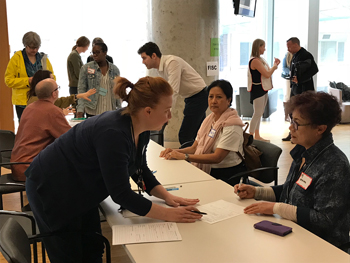Simulating a worst-case emergency to prepare for best practice

By Selma Al-Samarrai

Volunteer participants playing the role of concerned family members interact with FISC staff during the emergency simulation exercise. (Photo by Selma Al-Samarrai)
As one of the city’s two adult trauma hospitals, it’s important that our teams and organization are prepared for any major crisis event to quickly assess, triage and treat critically injured patients who require emergency care.
There are many different aspects to emergency preparedness, and being able to practise as a team through simulation exercises that paint worst-case scenarios is core to allowing our teams – clinical and support staff from across the hospital – to work together through a co-ordinated response.
In these scenarios, St. Michael’s runs a service called the Family Information Services Centre (FISC). The FISC ensures worried and anxious family members, who are separated from their loved ones with no information or indication if they are even alive, are supported.
Below, Lauren Massey, manager of Collaborative Practice and Education, Psychosocial Group, walks us through a recent simulation exercise held at St. Michael’s and explains how the FISC team practise and prepare to respond and support families when the worst happens.
The background of the simulation exercise is that there has been a subway crash in Toronto, and numerous patients were rushed to the Emergency Department at St. Michael’s.
The simulation begins when scores of worried, anxious and agitated family members and loved ones come rushing in to confirm whether their loved one is here, and how they’re doing.
The first point of contact for them is FISC. Run by the social work and spiritual care staff at St. Michael’s, the FISC’s responsibility is to provide information and emotional and crisis support to family members, as they work to identify the patient and reunite them with their loved ones.
“The simulation exercise is important because it can happen in real life. Emergency preparedness will help us define our roles during a Code Orange and prepare and empower us to perform as best as we can,” said Massey.
Did you know? A “Code Orange” in Ontario hospitals is an emergency code that is called when there has been an external disaster and the hospital is now managing the large and sudden flow of people who were affected by it. |
The simulations covered the first stage of FISC staff’s role in a Code Orange, when family members are initially supported as they arrive looking for their loved ones. In real life, the FISC’s role extends to matching the family member to an admitted patient, and then taking the family to reunify at the patient’s bedside.
“In social work, we are trained to deal with what’s difficult and how to support our patients and families when we just don’t have answers. We help the people we work with to be comfortable in that uncomfortable place,” explained Massey.
Over the last few years, St. Michael’s FISC organizers worked closely with their Toronto colleagues at the University Health Network and Sunnybrook Health Sciences Centre on best practice guidelines for how to run a FISC in a Code Orange.
“Although crisis management is a part of a social worker’s training, creating a process in response to a mass casualty incident is not something you learn, so all the FISC leaders in the city had to come together to ask what the other is doing and if we can share information. It’s been an amazing platform for communication, sharing and building,” explained Massey.
Massey said they are still going through the large volume of feedback received by the approximately 100 volunteers, FISC staff and observers from the simulation exercise, and assessing exactly what they need to change and improve based on the participants’ feedback.
“We have great clinicians at St. Michael’s, so I have no doubt in my mind that we could come together in a real-life Code Orange, but we can always learn, share and perform better in supporting families and loves ones for our patients,” said Massey.
About St. Michael’s Hospital
St. Michael’s Hospital provides compassionate care to all who enter its doors. The hospital also provides outstanding medical education to future health care professionals in more than 29 academic disciplines. Critical care and trauma, heart disease, neurosurgery, diabetes, cancer care, care of the homeless and global health are among the Hospital’s recognized areas of expertise. Through the Keenan Research Centre and the Li Ka Shing International Healthcare Education Centre, which make up the Li Ka Shing Knowledge Institute, research and education at St. Michael’s Hospital are recognized and make an impact around the world. Founded in 1892, the hospital is fully affiliated with the University of Toronto.
